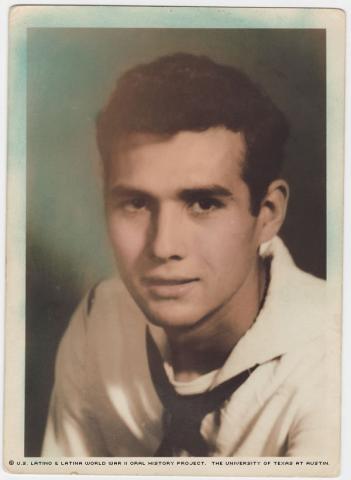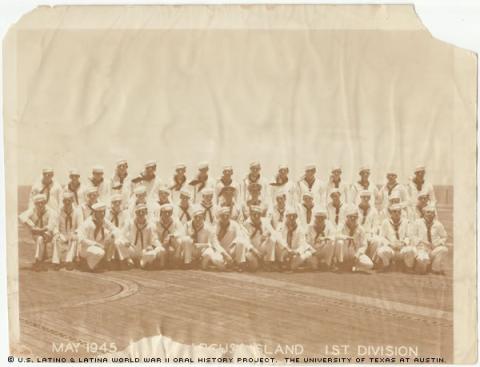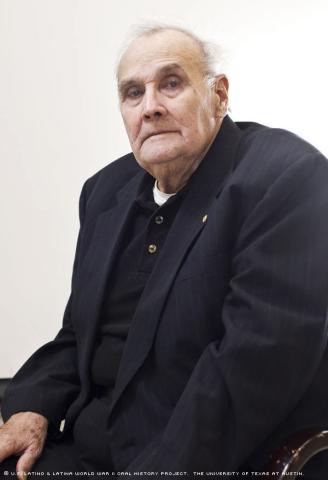


By Cheryl Smith Kemp
Joe Henry Lazarine’s interview is more of a conversation between two old friends than a question and answer session. After all, Lazarine was raised in Beeville, and so was interviewer Eloy Rodriguez, the son of one of Lazarine’s longtime compadres.
According to U.S. census data, Beeville’s population is approximately 12,680. It’s the largest city in Bee County, part of a region of South Texas rich in segregation history, so it’s not surprising these two Mexican Americans know each other well.
“Just relax. Just like we’re at your house,” said Eloy, also a veteran, but of the Vietnam War.
A listener can hear off screen Lazarine’s oldest daughter, Angeline Lazarine Alaniz, whispering details and clarifications to Eloy. Because, truth be told, Lazarine, 83 at the time of his interview, needs a little help here and there.
“Times were hard. …That was during the Depression. If we wanted a Christmas tree, my daddy used to go to … los montes to get one instead of buying one. He worked cheap, $15 a week. My mother, también [too],” said Lazarine of growing up in Beeville and, before that, relatively nearby Goliad.
His father, Guadalupe Lazarine, worked at the local Montgomery Ward and his mother, Guadalupe Perez Lazarine, at J.C. Penny. Like Lazarine himself, it was a modest life.
Plucking turkeys part time in the afternoons for five cents a bird, he went to school until the 11th grade at West Side, the local high school for Latinos in those days, at which point he got drafted into World War II.
Lazarine joined the Navy on April 13, 1944, and was sent to San Diego, Calif., for Basic Training, where he learned an essential survival skill, especially for sailors.
“They showed me” how to swim, he said.
For the next two years, Lazarine was a gunner in the Pacific on aircraft carrier CVE 77, commonly known as the USS Marcus Island.
According to Project military historian Bill Davies, the Marcus Island was “part of a composite task force, [called] Taffy 3, of only destroyers and escort carriers [that] defended the unarmed transports of the invasion” of Leyte island in the Philippines.
Interestingly, the U.S. force initially given that assignment, Admiral Halsey’s 3rd Fleet, was lured away from Leyte, so when Japanese “battleships, cruisers and destroyers appeared at Samar Island, just north of [the] Leyte landings,” Taffy 3’s commander, “facing impossible odds, ordered all his destroyers to charge, with all weapons firing, and his escort carriers to attack with all planes. This suicidal attack worked,” said Davies in an e-mail, because Japan’s “admiral thought he had run into Admiral Halsey’s Fleet and turned and ran, with heavy losses. Taffy 3 lost 2 destroyers and one escort carrier and saved [General Douglas MacArthur’s] return to the” Philippine Islands.
So not only did Lazarine participate in the invasion at Leyte, he survived one of WWII’s more harrowing sea missions.
“I only stayed in the Navy 26 months,” he said matter-of-factly.
Lazarine got discharged May 21, 1946, at the rank of Seaman First Class, at which point he returned to Beeville, where his proud parents were excited to see their only child.
“They looked for some medals but they couldn’t find them,” said Lazarine with a self-deprecating chuckle.
In actuality, he earned an Asia Pacific Campaign medal with four bronze service stars and a Philippine Liberation ribbon with two bronze service stars.
He also got a job in the tire department at Montgomery Ward, and, on July 6, 1947, married Frances Garza, whom he recalls meeting in 1945, when she was 16, at a watermelon party his parents threw for him while he was on leave from the service. Sixty-one years of marriage later, they’re still together, with three daughters and a son.
Since coming back from the war, Lazarine has also run a liquor store, as well as sold cars, appliances, furniture and insurance. He has also been a member since then of the American GI forum, which, according to its website, www.agifusa.com, has become “the largest Federally Chartered Hispanic Veterans organization in the United States[,] with Chapters in 40 states and Puerto Rico.
Eloy thanks Lazarine for getting involved and fighting for the rights of Latinos.
“We had it más fácil, easier, because of what y’all did growing up,” Eloy said. “We appreciate you doing that.”
“You’re a good man, Eloy,” said Lazarine near the end of his interview.
“Well, you’re a better man than I am,” Eloy said.
Joe Henry Lazarine was interviewed in Beeville, Texas, on January 10, 2009, by Eloy Rodriguez.

